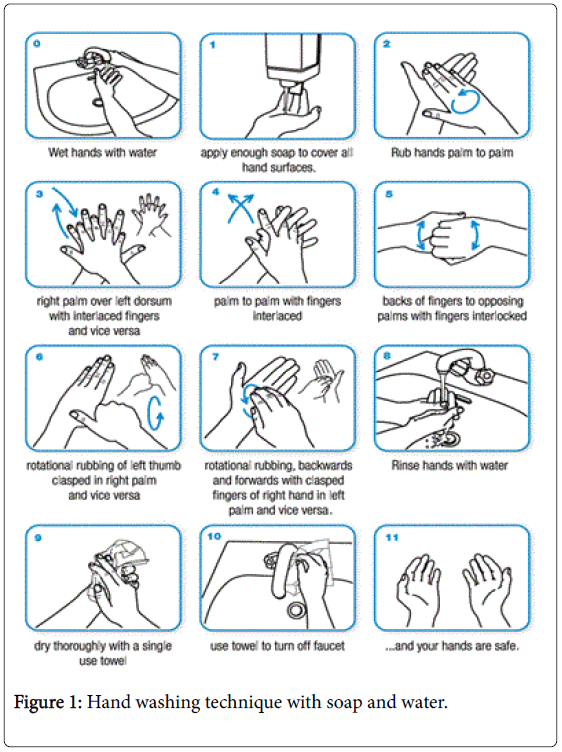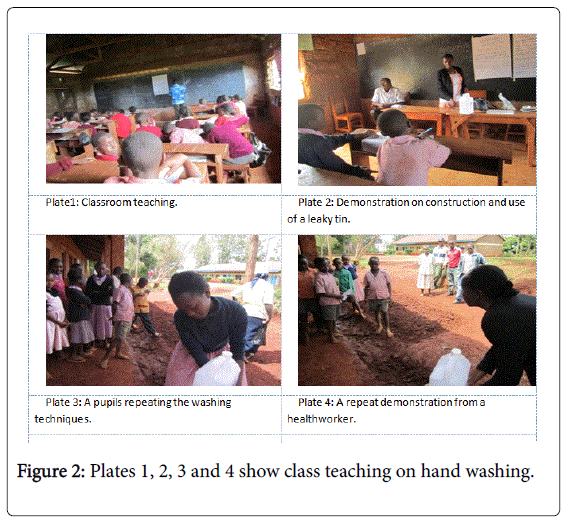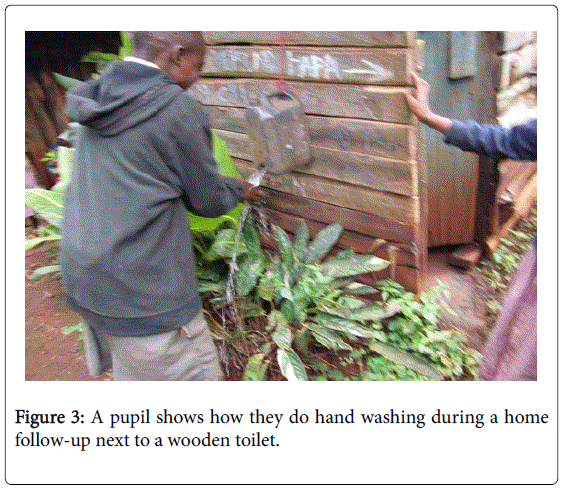Review Article Open Access
Primary School Pupils in Kenya Learn and Practice Good Hygiene
Gladys Njura Gitau*, Judith O Kimiywe, Judith N Waudo and Dorcus Mbithe
Department of Foods Nutrition and Dietetics, Kenyatta University, P.O.Box 43844, Nairobi, Kenya
- *Corresponding Author:
- Gladys Njura Gitau
Department of Foods Nutrition and Dietetics
Kenyatta University, P.O.Box 43844, Nairobi, Kenya
Tel: +254-722671727
E-mail: njuragg@yahoo.com
Received Date: Dec 02, 2015; Accepted Date: Dec 26, 2015; Published Date: Dec 29, 2015
Citation: Gitau GN, Kimiywe JO, Waudo JN, Mbithe D (2016) Primary School Pupils in Kenya Learn and Practice Good Hygiene. J Child Adolesc Behav 3:267. doi:10.4172/2375-4494.1000267
Copyright: © 2015 Gitau GN, et al. This is an open-access article distributed under the terms of the Creative Commons Attribution License, which permits unrestricted use, distribution, and reproduction in any medium, provided the original author and source are credited.
Visit for more related articles at Journal of Child and Adolescent Behavior
Abstract
Most health problems are directly or indirectly associated with environmental sanitation. Most illnesses could be associated with personal hygiene and sanitation of the pupils. Freund, Graybill, and Keith, 2005) in their study in Zambia reported that little was actually known about health of children from 6-15 years and much still remains to be learned. Research now shows that risk of poor health continues throughout childhood and children's health status especially of girls, which actually worsens from age 5-15 years. Several studies have indicated a connection between hand sanitization and infection control in numerous settings such as extended care facilities, schools, and hospitals. Hand hygiene practices improve through increased frequency of hand washing and by increasing awareness of the importance of hand hygiene. This results in fewer Upper Respiratory Infection symptoms, lower illness rates, and lower absenteeism from school. Hand-hygiene interventions are efficacious for preventing gastrointestinal illnesses, in both developed and lesser-developed countries.
Keywords
Hygiene; School; Kenya; Environmental
Introduction
Most health problems are directly or indirectly associated with environmental sanitation. Most illnesses could be associated with personal hygiene and sanitation of the pupils [1]. In their study in Zambia reported that little was actually known about health of children from 6-15 years and much still remains to be learned. Research now shows that risk of poor health continues throughout childhood and children's health status especially of girls, which actually worsens from age 5-15 years
Several studies have indicated a connection between hand sanitization and infection control in numerous settings such as extended care facilities, schools, and hospitals. Hand hygiene practices improve through increased frequency of hand washing and by increasing awareness of the importance of hand hygiene. This results in fewer Upper Respiratory Infection symptoms, lower illness rates, and lower absenteeism from school. Hand-hygiene interventions are efficacious for preventing gastrointestinal illnesses, in both developed and lesser-developed countries [2].
In Kenya, the likelihood of faecal contamination of the school environment is high because many schools have few latrines, inadequate water supplies, poor quality of available water sources, water storage in containers that permit hands to touch and contaminate stored water and lack of hand-washing facilities [3]. Besides impacting on school attendance, the resulting burden of diarrhoeal diseases and parasitic infestations has a negative impact on students' growth, nutritional status, physical activities, cognition, concentration and school performance [4].
There is a need to design novel strategies for preventive interventions that could allow inclusion of school children as well as adults in an effort to reduce force of infection and re-infection in high endemic communities even where there are school deworming programmes [5].
Compared to adults, children can easily change their behaviour as a result of increased knowledge and facilitated practices and also as role models for their peers [6]. Knowledge is necessary for practice of proper hygiene in the school environment and households. Hand hygiene is clearly effective against gastro-intestinal and, to a lesser extent, respiratory infections. Many studies have reported an association between improvements in hand hygiene and reductions in rates of infectious illnesses in the community [2]. The current study was aimed at improving on hand washing techniques among school pupils of Gatanga Sub-County, Muranga County, Kenya for better health.
Methodology
An interview schedule and a questionnaire were administered to the caregivers and pupils respectively to the randomly sampled boys and girls for the assessment of health, hygiene and sanitation practices. Data were analysed for the baseline study and gaps identified that needed interventions. Health education was taught to the pupils. Lesson plans showing the lesson organization and presentation were also made with guideline from the classroom curriculum chart and Class 5 and 6 Science books [7-10].
The pupils’ were taught using visual aids where necessary. Real objects like the leaky tins and soap were used to demonstrate hand washing following the World Health Organization hand washing techniques (Figures 1 and 2). Adopted from WHO, 2015: Handwashing Techniques [11]. The pupils and their parents were trained on proper personal hygiene, Food safety while preparing meals, use of toilets and hand washing after visiting the toilet. Demonstrations on leaky tin (an improvised container to hold hand-washing water) construction, proper hand washing using soap and making dish-racks were taught by the field public health staff.
Results
Hand washing needs improvement for most individuals because rarely do populations follow the WHO rules of hand washing. Many school teachers and management have the basic knowledge on hand washing rules but many factors are limiting to achieve this. This includes availability of clean safe water, gadgets like leaky tins within the ablution blocks and soap for hand washing. Based on the interviews, the study indicated that 68% of the children washed hands after visiting the toilet while 32% did not at baseline. There could have been over-reporting on hand washing because the schools sources of water were far away and no leaky tins were in visibility. Many did not use soap in hand washing at baseline. Improvement on hand washing with water and soap was noted after the interventions.
In order to avert the harmful effects and complications of intestinal parasites, prompt preventive measures should be taken for the eradication of the high infestation rate which should include public health education, clean drinking water, sanitation facilities, promoting personal hygiene and periodic deworming of the children. Health and sanitation knowledge was offered to the experimental schools with the assistance of public health office. After the interventions, the pupils improved in hand-washing and use of leaky tins.
Leaky tins use in households
Children's potential effectiveness as agents of change in the home was revealed by a study in Nyanza, whereby parents/guardians reported changing their hand washing behaviour because of what their children had told them about hand washing from lessons at school [4].
Leaky tins are containers that are improvised for hand washing purpose in areas where running water is not available using locally available materials like empty cans of any size. These tins are pierced at the bottom with a nail to release water and then covered with a fitting stick after use. Leaky tin use improved in intervention schools with twelve out of fourty three households visited having adopted use of the leaky tins. Plate 5 shows a pupil with a leaky tin at home during the home follow-up by the researcher and performance in leaky tins use in pupils’ households respectively (Figure 3).
From the results, it can be concluded that hand washing intervention was successful and led to improved hand-washing amongst the study pupils.
Conclusion
Emphasis should be laid on the importance of personal hygiene, food safety and diseases associated with lack of observance in good personal hygiene both at school and home. Introduction of ‘‘leaky tins’’ next to the toilets and hand washing is of importance. Nutritionists and health workers should continuously educate households and schools to ensure all hygienic practices are observed. This includes hand washing, treated or boiled drinking water at school and households and the use of dish-racks at household level to reduce illnesses which would also reduce school absenteeism. This calls for action amongst the stakeholders to address this health problem amongst this age category.
References
- Freund P, Graybill E, Keith N (2005) Health and Education Working Together. A case study of a successful school health and nutrition model,pp: 1-10.
- Aiello AE, Coulborn RM, Perez V, Larson EL (2008) Effect of Hand Hygiene on Infectious Disease Risk in the Community Setting: A Meta-Analysis. Promoting Public health Reasearch Policy, Practice and Education. Am J Public Health 98: 1372-1381.
- Ministry of Education (2009) National School Health Policy. Ministry of Public Health and Sanitation and Ministry of Education.
- O’reilly CE, Freeman MC, Ravani M, Migele J, Mwaki A, et al.(2006) The Impact of School-based safe water and hygiene programme on knowledge and practice of students and their parents: Nyanza Province, Western Kenya, 2006. Epidemiol Infect 136: 80-91.
- Njenga SM, Mwandawiro CS, Muniu E, Mwanje MT, Haji FM, et al. (2011) Adult population as potential reservoir of NTD infections in rural villages of Kwale district, Coastal Kenya: I mplications for preventive chemotherapy interventions policy. Parasites & Vectors 4:175.
- Guiney AM (2010) Call to Action for WASH in Schools. Drinking water, sanitation and Hygiene- WASH in schools.
- Food and Agriculture Organization (2005) Classroom Curriculum Chart. Learning Objectives For Nutrition Education in Primary Schools in Developing Countries. Promoting Lifelong Health.
- Vasishta SK, Patel NM (2002) Learning Science for standard 5, Latest Revised Syllabus. Malimu Publications pp: 59-119.
- Alex B, Njenga J, Embeywa H (2010) Science in Action, Pupils Book 5. Oxford New Syllabus, University Press, East Africa Ltd, Nairobi Kenya pp: 56-63.
- Alex J (2011) Nutrient Guide: Food Composition Tables for More Than 400 Natural and Conventional Foods. Update on America’s Vanishing Nutrients, 2011 planetary Health/Amberwavespp: 8-33.
- WHO (2015) Clean Care is Safer Care. Clean hands protect against infection.
Relevant Topics
- Adolescent Anxiety
- Adult Psychology
- Adult Sexual Behavior
- Anger Management
- Autism
- Behaviour
- Child Anxiety
- Child Health
- Child Mental Health
- Child Psychology
- Children Behavior
- Children Development
- Counselling
- Depression Disorders
- Digital Media Impact
- Eating disorder
- Mental Health Interventions
- Neuroscience
- Obeys Children
- Parental Care
- Risky Behavior
- Social-Emotional Learning (SEL)
- Societal Influence
- Trauma-Informed Care
Recommended Journals
Article Tools
Article Usage
- Total views: 14411
- [From(publication date):
December-2015 - Apr 06, 2025] - Breakdown by view type
- HTML page views : 13299
- PDF downloads : 1112



